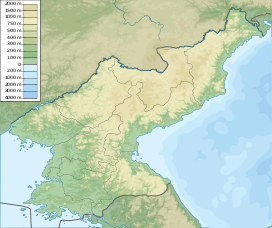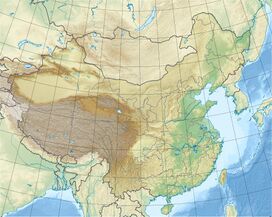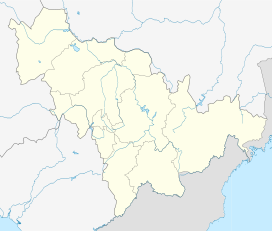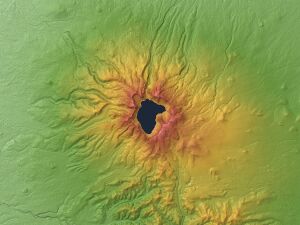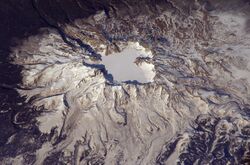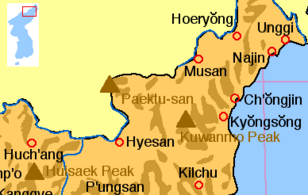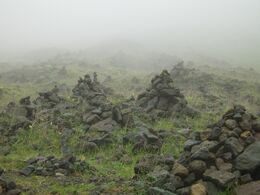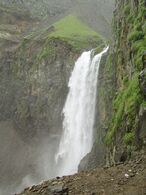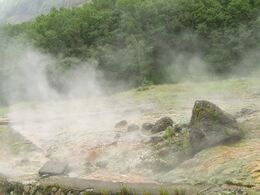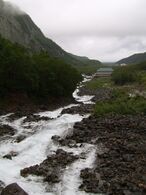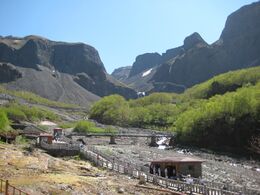جبل پكتو
| Paektu Mountain | |
|---|---|
| 백두산 / 白頭山 (كورية) 长白山 (صينية) | |
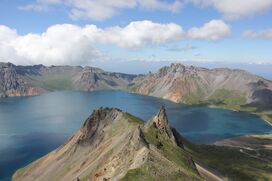 كالديرة قمة جبل پكتو، مع بحيرة السماء | |
| أعلى نقطة | |
| الارتفاع | 2،744 m (9،003 ft)[1] |
| البروز | 2،593 m (8،507 ft)[1] |
| الإدراج | Country high point Ultra |
| الإحداثيات | 41°59′36.3″N 128°04′39.3″E / 41.993417°N 128.077583°E |
| الجغرافيا | |
| Location | |
| السلسلة الأم | Changbai Mountains |
| الجيولوجيا | |
| نوع الجبل | Stratovolcano |
| آخر ثوران | March 1903[2] |
| جبل پكتو | |||||||||
|---|---|---|---|---|---|---|---|---|---|
| Chinese name | |||||||||
| الصينية المبسطة | 长白山 | ||||||||
| الصينية التقليدية | 長白山 | ||||||||
| المعنى الحرفي | ever-white mountain | ||||||||
| |||||||||
| Korean name | |||||||||
| Chosŏn'gŭl | 백두산 | ||||||||
| Hancha | 白頭山 | ||||||||
| Literal meaning | white head mountain | ||||||||
| |||||||||
| Chinese Korean name | |||||||||
| Chosŏn'gŭl | 장백산 | ||||||||
| Hancha | 長白山 | ||||||||
| Literal meaning | ever-white mountain | ||||||||
| |||||||||
| Manchu name | |||||||||
| Manchu script | ᡤᠣᠯᠮᡳᠨ ᡧᠠᠩᡤᡳᠶᠠᠨ ᠠᠯᡳᠨ | ||||||||
| Romanization | Golmin Šanggiyan Alin | ||||||||
جبل پـِكتو Paektu Mountain أو جبل بـِكدو Baekdu Mountain هو active stratovolcano on the الحدود الصينية الكورية الشمالية.[3] It is called in Chinese Changbai Mountain and in Manchu Golmin Šanggiyan Alin. At 2،744 m (9،003 ft), it is the tallest mountain in North Korea and Northeast China and the tallest mountain of the Baekdu-daegan and Changbai mountain ranges. The mountain notably has a caldera that contains a large crater lake called Heaven Lake, and is also the source of the Songhua, Tumen, and Yalu rivers. Korean and Manchu people assign a mythical quality to the mountain and its lake, and consider the mountain to be their ancestral homeland.
The mountain's caldera was formed by an eruption in 946 that released about 100–120 km3 (24–29 cu mi) of tephra. The eruption was among the largest and most powerful eruptions on Earth in the last 5,000 years. The volcano last erupted in 1903, and is expected to erupt around every hundred years. In the 2010s, concerns over an upcoming eruption prompted several countries to commission research into when the volcano might next erupt.[needs update]
The mountain is considered culturally important to multiple groups in the area, including Korean, Chinese, and Manchu people. The mountain is a major national symbol for both North and South Korea, and is mentioned in both national anthems and depicted on the national emblem of North Korea. The Manchu people also consider the mountain their ancestral homeland, and the Chinese Qing dynasty saw it as a symbol of imperial power. The mountain has also been subject to territorial disputes over the past few centuries that have continued into the present.
الأسماء
The mountain was first recorded in the Chinese Classic of Mountains and Seas under the name Bùxián Shān (الصينية: 不咸山). It is also called Shànshàn Dàlǐng (الصينية: 單單大嶺) in the Book of the Later Han. In the New Book of Tang, it was called Tàibái Shān (الصينية: 太白山).[4] The current Chinese name, Chángbái Shān (长白山; 長白山, 'ever white mountain', was first used in the Liao dynasty (916–1125) of the Khitans[5] and then the Jin dynasty (1115–1234) of the Jurchens.[6] The Liao Shi recorded that chiefs of 30 Jurchen tribes from Mount Changbai paid their tribute to the Liao in AD 985. According to the Song dynasty travelogue Songmo Jiwen, it was named as such because the mountain was "the abode of the white-robed Guanyin" and its birds and beasts were all white.[7] The modern Manchu name of the mountain, which is golmin šanggiyan alin (ᡤᠣᠯᠮᡳᠨ ᡧᠠᠩᡤᡳᠶᠠᠨ ᠠᠯᡳᠨ), also means 'ever white mountain'.
The modern Korean name of the mountain, Paektusan or Baekdusan (백두산/白頭山), was first recorded in the 13th-century historical record Goryeosa. It means 'white-head mountain'. In other records from the same period, the mountain was also called Taebaeksan (태백산, 太白山), which means 'great-white mountain'. An alternative Chinese name, Báitóu Shān (白头山; 白頭山), is the transliteration of Paektu Mountain.[8]
The Mongolian name is Öndör Tsagaan Aula (Өндөр Цагаан Уул), which means 'lofty white mountain'. In English, various authors have used nonstandard transliterations.[9]
الجغرافيا والجيولوجيا
Mount Paektu is 2،744 m (9،003 ft) tall, making it the highest mountain in North Korea and Northeast China and the highest mountain of the Baekdu-daegan and Changbai mountain ranges.[10]
Mount Paektu is a stratovolcano whose cone is truncated by a large caldera. The central section of the mountain rises about 3 mm (0.12 in) per year due to rising levels of magma below the central part of the mountain. Sixteen peaks exceeding 2،500 m (8،200 ft) line the caldera rim surrounding Heaven Lake. The highest peak, called Janggun Peak, is covered in snow about eight months of the year. The slope is relatively gentle until about 1،800 m (5،910 ft). The caldera is about 5 km (3.1 mi) wide and 850 متر (2،790 ft) deep, and is partially filled by the waters of Heaven Lake.[2]
Heaven Lake has a circumference of 12 إلى 14 كيلومتر (7.5 إلى 8.7 mi), with an average depth of 213 متر (699 ft) and maximum depth of 384 متر (1،260 ft). From mid-October to mid-June, the lake is typically covered with ice. Water flows north out of the lake, and near the outlet there is a 70-متر (230 ft) waterfall. The mountain is the source of the Songhua, Tumen and Yalu rivers. The Tumen and the Yalu form the northern border between North Korea and Russia and China.
المناخ
The weather on the mountain can be very erratic, sometimes severe. The annual average temperature at the peak is −4.9 °C (23.2 °F). During summer, temperatures of about 18 °C (64 °F) or higher can be reached, and during winter temperatures can drop to −48 °C (−54 °F). The lowest record temperature was −51 °C (−60 °F) on 2 January 1997. The average temperature is about −24 °C (−11 °F) in January, and 10 °C (50 °F) in July, remaining below freezing for eight months of the year. The average wind speed is 42 km/h (26 mph), peaking at 63 km/h (39 mph). The relative humidity averages 74%.[بحاجة لمصدر]
التاريخ الجيولوجي
The geological origin of Mount Paektu remains a mystery. Two leading theories are first a hot spot formation and second an uncharted portion of the Pacific Plate sinking beneath Mount Paektu.[11]
Beginning about 5 million years ago, Paektu Mountain erupted, releasing a series of basaltic lava flows that formed a lava plateau. The construction of the cone of the volcano began approximately 1 million years ago, as the eruptive materials transitioned into trachytic pyroclastic and lava flows. During the cone-construction stage, major Plinian-type eruptions occurred in 448, 67.6, 85.8 and 24.5 thousand years ago (ka) and deposited ash in the Japan sea.[12] The cone's growth was halted by two widely-recognized major explosive eruptions: Tianwenfeng and Millennium.[12][13][14]
ثوران تيانونفنج
The Tianwenfeng eruption was the formation of a widespread thick layer of grey, yellow pumice preceding the Millennium eruption.[12][13][14][15][16] The exact age of the eruption is uncertain, since different dating techniques have assigned 4, 51, 61, and 74 ka to this deposit.[15][13] This eruption formed large areas covered in yellow pumice and ignimbrite.[17] Proximal deposits of pumice fall of the Tianwenfeng are thicker than those of the Millennium eruption. This suggests that the eruption of the Tianwenfeng is significant and maybe of similar magnitude to the Millennium eruption, making the Tianwenfeng eruption also of VEI 6–7.[13]
ثوران الألفية
The mountain's caldera was created in 946 by the colossal (VEI 6)[18] "Millennium" or "Tianchi" eruption, one of the most powerful eruptions in the last 5,000 years, comparable to the 230 AD eruption of Lake Taupō and the 1815 eruption of Mount Tambora.[19] The eruption, whose tephra has been found in the southern part of Hokkaidō, Japan, and as far away as Greenland,[20] destroyed much of the volcano's summit, leaving a caldera that today is filled by Heaven Lake.
According to the Korean historical record Goryeosa, in 946 "thunders from heaven's drum" were heard in the city of Kaesong, then the capital of Goryeo, about 450 km (280 mi) south of the volcano.[21] The event reportedly terrified King Jeongjong so much, that convicts were pardoned and set free.[21] According to the Heungboksa Temple's historical records, on 3 November, "white ash rain" fell in Nara, Japan, about 1،100 km (680 mi) southeast from the mountain[21] Three months later, on 7 February 947, explosive noises were reported in the city of Kyoto (Japan), about 1،000 km (620 mi) southeast of Paektu.[21]
التاريخ اللاحق
After these major eruptions, Mount Paektu had at least three smaller eruptions, which occurred in 1668, 1702, and 1903, likely forming the Baguamiao ignimbrite, the Wuhaojie fine pumice, and the Liuhaojie tuff ring.[22]
أبحاث في الثوران القادم
In 2011, experts in North and South Korea met to discuss the potential for a significant eruption in the near future, as the last eruption was in 1903 and the volcano is expected to erupt around every 100 years.[23][24] The Government of North Korea invited several volcanologists, including James Hammond, Clive Oppenheimer, and Kayla Iacovino, to study the mountain for recent volcanic activity.[25][26] Iacovino became the first foreign female researcher to conduct research in North Korea.[27][28] The researchers began publishing their research in 2016 and in February 2020 formed the Mt. Paektu Research Center.[29]
النبيت والوحيش
There are five known species of plants in the lake on the peak, and some 168 have been counted along its shores. The forest on the Chinese side is ancient and almost unaltered by humans. Birch predominates near the tree line, and pine lower down, mixed with other species. There has been extensive deforestation on the lower slopes on the North Korean side of the mountain.[بحاجة لمصدر]
The area is a known habitat for Siberian tigers, bears, wolves, and wild boars.[30] The Ussuri dholes may have been extirpated from the area. Deer in the mountain forests, which cover the mountain up to about 2،000 متر (6،600 ft), are of the Paekdusan roe deer kind. Many wild birds such as black grouse, owls, and woodpecker are known to inhabit the area. The mountain has been identified by BirdLife International as an Important Bird Area (IBA) because it supports a population of scaly-sided mergansers.[31]
التاريخ
The mountain has been worshipped by the surrounding peoples throughout history. Both the Koreans and Manchus consider it sacred, especially the Heaven Lake in its crater.[32][33]
كوريا
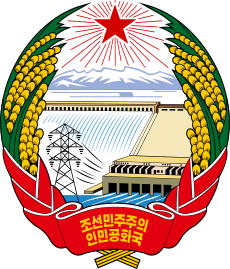
The mountain has been considered sacred by Koreans throughout history.[33] According to Korean mythology, it was the birthplace of Dangun, the founder of Gojoseon (2333–108 BC), whose parents were said to be Hwanung, the Son of Heaven, and Ungnyeo, a bear who had been transformed into a woman.[34] The Goryeo and Joseon dynasties also worshiped the mountain.[35][36]
The Goryeo dynasty (935–1392) first called the mountain Paektu,[37] recording that the Jurchens across the Yalu River were made to live outside of Mount Paektu. The Joseon dynasty (1392–1910) recorded volcanic eruptions in 1597, 1668, and 1702. In the 15th century, King Sejong strengthened the fortification along the Tumen and Yalu rivers, making the mountain a natural border with the northern peoples.[38] Some Koreans claim that the entire region near Mount Paektu and the Tumen River belongs to Korea and parts of it were illegally given away by Japanese colonialists to China through the Gando Convention.[بحاجة لمصدر]
Mount Paektu is mentioned in the national anthems of both North and South Korea and in the Korean folk song "Arirang".
Dense forest around the mountain provided bases for Korean armed resistance against the Japanese occupation, and later communist guerrillas during the Korean War. Kim Il Sung organized his resistance against the Japanese forces there, and North Korea claims that Kim Jong Il was born there,[39] although records outside of North Korea suggest that he was actually born in the Soviet Union.[40][41]
The peak has been featured on the state emblem of North Korea since 1993, as defined in Article 169 of the Constitution, which describes Mt. Paektu as "the sacred mountain of the revolution".[42] The mountain is often referred to in slogans such as: "Let us accomplish the Korean revolution in the revolutionary spirit of Paektu, the spirit of the blizzards of Paektu!"[43] North Korean media also celebrates natural phenomena witnessed at the mountain as portentous,[44] and Korean Central Television's weather reports list Paektu behind only Pyongyang.[45] The mountain's name is used for various products, such as the Paektusan rocket, the Paektusan computer, and the Mt Paektu handgun.[46][47][48]
الصين
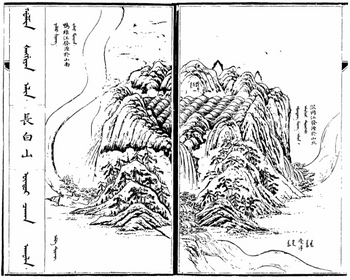
Mount Changbai was regarded as the most sacred mountain in the shamanist religion of the Manchus, and their ancestors Sushen and Jurchens.[49] The Jin dynasty bestowed the title "the King Who Makes the Nation Prosperous and Answers with Miracles" (الصينية: 興國靈應王) on the mountain in 1172 and it was entitled "the Emperor Who Cleared the Sky with Tremendous Sagehood" (الصينية: 開天宏聖帝) in 1193. A temple for the mountain god was constructed on the northern side.[7]
The Manchu clan Aisin Gioro, which founded the Qing dynasty of China, claimed their progenitor Bukūri Yongšon was conceived near Paektu Mountain. In 1682, 1698, 1733, 1754 and 1805, Qing emperors visited Jilin and paid homage to the mountain. The rites at Mount Changbai were heavily influenced by the ancient Feng Shan ceremonies, in which Chinese emperors offered sacrifices to heaven and earth at Mount Tai. The Kangxi Emperor claimed that Mount Tai and Changbai belong to the same mountain range, which runs from northeast to southwest but is partially submerged under the sea before reaching Shandong. The geography and feng shui of Mount Changbai thus provided legitimacy to the Aisin Gioro clan's rule over China.[49]
Baishan Heishui, "white mountain and black river", referring to Mount Changbai and the Heilongjiang, has been a traditional name for Northeast China since the Jin dynasty.[50]
النزاع على السيادة
التاريخية

According to Annals of the Joseon Dynasty, the Yalu and Tumen Rivers were set as the borders in the era of the founder of Joseon Dynasty, Taejo of Joseon (1335–1408).[51] Because of the continuous entry of Korean people into Gando, a region in Manchuria that lay north of the Tumen, Manchu and Korean officials surveyed the area and negotiated a border agreement in 1712. To mark the agreement, they built a monument describing the boundary at a watershed, near the south of the crater lake at the mountain peak.
Since the 19th century, interpretations of the inscription have been relevant in some territorial disputes.[بحاجة لمصدر]
The 1909 Gando Convention between China and Japan, when Korea was under Japanese rule, recognized the north and east of the mountain as Chinese territory.[52]
مؤخراً
In 1962 and 1964, China and North Korea negotiated two treaties in secret that outlined their modern borders. Both treaties especially focused on the sovereignty of Paektu and Heaven Lake. As a result of the treaties, North Korea received 280 km2 (110 sq mi)[53] of land on and around Paektu, and 54.5% of Heaven Lake.[54][55][52] Neither treaty is recognized by the governments of Taiwan or South Korea.[52]
اعتبارا من 2013[تحديث], South Korea formally claimed the caldera lake and the inside part of the ridge.[56] However, some South Korean groups argue that recent activities conducted on the Chinese side of the border, such as economic development, cultural festivals, infrastructure development, promotion of the tourism industry, attempts at registration as a World Heritage Site, and bids for a Winter Olympic Games, constitute attempts to claim the mountain as Chinese territory.[57][58] These groups object to China's use of the name Mount Changbai.[6] Some groups also regard the entire mountain as Korean territory that was given away by North Korea in the Korean War.[58]
During the 2007 Asian Winter Games, which were held in Changchun, China, a group of South Korean athletes held up signs during the award ceremony which stated "Mount Paektu is our territory". Chinese sports officials delivered a letter of protest on the grounds that political activities violated the spirit of the Olympics and were banned in the charter of the International Olympic Committee and the Olympic Council of Asia. Officials from the South Korean athletic team apologized to China.[59][60][61]
السياحة
Most Chinese, South Korean, and international visitors climb the mountain from the Chinese side. The North Korean side of the mountain is also popular among visitors to North Korea.[بحاجة لمصدر] The Chinese tourism area is classified as a AAAAA scenic area by the China National Tourism Administration.[62]
There are a number of monuments on the North Korean side of the mountain. Paektu Spa is a natural spring and is used for bottled water.[بحاجة لمصدر] Pegae Hill is a camp site of the Korean People's Revolutionary Army (بالكورية: 조선인민혁명군) allegedly led by Kim Il Sung during their struggle against Japanese colonial rule.[بحاجة لمصدر] Secret camps are also now open to the public. There are several waterfalls, including the Hyongje Falls which splits into two about a third of the way from the top.[بحاجة لمصدر] In 1992, on the occasion of the 80th birthday of Kim Il-sung, a large sign with the words "Holy mountain of the revolution" written in metal letters was erected on the side of the mountain.[بحاجة لمصدر] North Koreans[من؟] claim that there are 216 steps leading to the top of the mountain, symbolizing Kim Jong Il's 16 February birth date, but this claim is disputed.[63] On the North Korean side of the mountain, there is a funicular system with two cars.[64] This was updated with new funicular cars built by the Kim Chong-t'ae Electric Locomotive Works, with the new cars successfully running on the funicular from October 30.[65][66]
في الثقافة الشعبية
In the 2019 South Korean disaster film Ashfall, the mountain erupts and causes severe earthquakes in the Korean peninsula.[بحاجة لمصدر]
انظر أيضاً
- جغرافيا كوريا الشمالية
- سلسلة جبال تشانگباي
- قمة جونگ-إيل
- List of ultras of Northeast Asia
- قائمة الجبال في كوريا
- قائمة البراكين في كوريا
- قائمة البراكين في الصين
- جغرافيا الصين
- جبل پكتو (قصيدة)
- جبال مقدسة
- جبال كوريا الخمس
المراجع
- ^ أ ب "Paektu-san, China/North Korea". Peakbagger.com.
- ^ أ ب خطأ لوا: expandTemplate: template "cite web archived" does not exist.
- ^ Andy Coghlan (15 April 2016). "Waking supervolcano makes North Korea and West join forces". NewScientist. Retrieved 17 May 2019.
- ^ Second Canonical Book of the Tang Dynasty. 《新唐書.北狄渤海傳》:"契丹盡忠殺營州都督趙翽反,有舍利乞乞仲象者,與靺鞨酋乞四比羽及高麗餘種東走,度遼水,保太白山之東北,阻奧婁河,樹壁自固。" (English translation: Khitan general Li Jinzhong killed Zhao Hui, the commanding officer of Yin Zhou. Officer Dae Jung-sang, with Mohe chieftain Qisi Piyu and Goguryeo remnants, escaped to the east, crossed Liao River, guarded the northeast part of the Grand Old White Mountain, blocked Oulou River, built walls to protect themselves.)
- ^ "Records of Khitan Empire". 《契丹國志》:"長白山在冷山東南千餘里......禽獸皆白。"(English translation: "Changbai Mountain is a thousand miles to the southeast of Cold Mountain...Birds and animals there are all white.")
- ^ أ ب "Canonical History Records of the Jurchen Jin Dynasty". 《金史.卷第三十五》:"長白山在興王之地,禮合尊崇,議封爵,建廟宇。""厥惟長白,載我金德,仰止其高,實惟我舊邦之鎮。" (English translation: "Changbai Mountain is in old Jurchen land, highly respectful, suitable for building temples. Only the Changbai Mountain can carry Jin Dynasty's spirit; It is so high; It is a part of our old land.")
- ^ أ ب 刘厚生. "寻脉长白山溯文化源起". 长春日报. Retrieved 20 May 2022.
- ^ ISBN 7-5031-2136-X p. 31
- ^ Examples: Paektu-san ("Paektu-san: North Korea". Retrieved 4 October 2010.) (Korean 백두산 ("백두산: North Korea". Retrieved 4 October 2010.)), Ch'ang Pai ("Ch'ang Pai: China". Retrieved 4 October 2010.), Chang-pai Shan,("Chang-pai Shan: China". Retrieved 4 October 2010.), Chōhaku-san ("Chōhaku-san: China". Retrieved 4 October 2010.), Hakutō ("Hakutō: China". Retrieved 4 October 2010.), Hakutō-san("Hakutō-san: China". Retrieved 4 October 2010.), Hakutō-zan ("Hakutō-zan: China". Retrieved 4 October 2010.), Paik-to-san ("Paik-to-san: China". Retrieved 4 October 2010.), Mount Paitoushar ("Mount Paitoushar: China". Retrieved 4 October 2010.), Paitow Shan ("Paitow Shan: China". Retrieved 4 October 2010.), Pei-schan ("Pei-schan: China". Retrieved 4 October 2010.), and Bai Yun Feng.
- ^ Ehlers, Jürgen; Gibbard, Philip (2004). Quaternary Glaciations: South America, Asia, Africa, Australasia, Antarctica. Elsevier.
The Changbai Mountain is the highest (2570 m a.s.l.) in north-eastern China (42°N, 128°E) on the border between China and Korea.
- ^ "NERC - Science without borders". Archived from the original on 26 April 2016. Retrieved 17 April 2016.
- ^ أ ب ت Zhang, Maoliang; Guo, Zhengfu; Liu, Jiaqi; Liu, Guoming; Zhang, Lihong; Lei, Ming; Zhao, Wenbin; Ma, Lin; Sepe, Vincenzo; Ventura, Guido (2018). "The intraplate Changbaishan volcanic field (China/North Korea): A review on eruptive history, magma genesis, geodynamic significance, recent dynamics and potential hazards". Earth-Science Reviews (in الإنجليزية). 187: 19–52. doi:10.1016/j.earscirev.2018.07.011. S2CID 135133402.
- ^ أ ب ت ث Pan, Bo; de Silva, Shanaka L.; Xu, Jiandong; Liu, Songjun; Xu, Dan (2020). "Late Pleistocene to present day eruptive history of the Changbaishan-Tianchi Volcano, China/DPRK: New field, geochronological and chemical constraints". Journal of Volcanology and Geothermal Research (in الإنجليزية). 399: 106870. doi:10.1016/j.jvolgeores.2020.106870. S2CID 218936429.
- ^ أ ب Wei, Haiquan; Liu, Guoming; Gill, James (2013-03-14). "Review of eruptive activity at Tianchi volcano, Changbaishan, northeast China: implications for possible future eruptions". Bulletin of Volcanology (in الإنجليزية). 75 (4): 706. Bibcode:2013BVol...75..706W. doi:10.1007/s00445-013-0706-5. ISSN 1432-0819. S2CID 128947824.
- ^ أ ب Sun, Chunqing; Liu, Jiaqi; You, Haitao; Nemeth, Karoly (2017). "Tephrostratigraphy of Changbaishan volcano, northeast China, since the mid-Holocene". Quaternary Science Reviews (in الإنجليزية). 177: 104–119. doi:10.1016/j.quascirev.2017.10.021.
- ^ Chen, Xuan-Yu; Blockley, Simon P. E.; Tarasov, Pavel E.; Xu, Yi-Gang; McLean, Danielle; Tomlinson, Emma L.; Albert, Paul G.; Liu, Jia-Qi; Müller, Stefanie; Wagner, Mayke; Menzies, Martin A. (2016-06-01). "Clarifying the distal to proximal tephrochronology of the Millennium (B–Tm) eruption, Changbaishan Volcano, northeast China". Quaternary Geochronology (in الإنجليزية). 33: 61–75. doi:10.1016/j.quageo.2016.02.003. ISSN 1871-1014. S2CID 28586567.
- ^ 刘, 若新 (1998). 长白山天池火山近代喷发 (in الصينية). 科学出版社. ISBN 9787030062857.
- ^ "Global Volcanism Program | Changbaishan". Smithsonian Institution | Global Volcanism Program (in الإنجليزية). Retrieved 2023-02-06.
- ^ Pan, Bo; Xu, Jiandong (2013). "Climatic impact of the Millennium eruption of Changbaishan volcano in China: New insights from high-precision radiocarbon wiggle-match dating" (PDF). Geophysical Research Letters. 40 (1): 54–59. Bibcode:2013GeoRL..40...54X. doi:10.1029/2012GL054246.
- ^ Sigl, M (2015). "Timing and climate forcing of volcanic eruptions for the past 2,500 years". Nature. 523 (7562): 543–49. Bibcode:2015Natur.523..543S. doi:10.1038/nature14565. PMID 26153860. S2CID 4462058.
- ^ أ ب ت ث 由紀夫, 早川; 真人, 小山 (1998). "日本海をはさんで10世紀に相次いで起こった二つの大噴火の年月日: 十和田湖と白頭山". 火山. 43 (5): 403–407. doi:10.18940/kazan.43.5_403.
- ^ Wei, Haiquan (2013). "Review of eruptive activity at Millennium volcano, Paektusan, northeast China: implications for possible future eruptions". Bull Volcanol. 75 (4). Bibcode:2013BVol...75..706W. doi:10.1007/s00445-013-0706-5. S2CID 128947824.
- ^ Stone, Richard (2011). "Vigil at North Korea's Mount Doom". Science Magazine. 334 (6056): 584–588. doi:10.1126/science.334.6056.584. PMID 22053023. Retrieved 16 December 2012.
- ^ Sam Kim, Yonhap (22 March 2011). "S. Korea agrees to talks on possible volcano in N. Korea". Yonhap News Agency. Retrieved 22 March 2011.
- ^ "Rumbling volcano sees N. Korea warm to the West". CBS News. 16 September 2014.
- ^ Hammond, James (9 February 2016). "Understanding Volcanoes in Isolated Locations". Science & Diplomacy. 5 (1).
- ^ Fleur, Nicholas St (2016-12-09). "Only a Rumbling Volcano Could Make North Korea and the West Play Nice". The New York Times (in الإنجليزية الأمريكية). ISSN 0362-4331. Retrieved 2020-09-10.
- ^ "Dr. Kayla Iacovino: In the footsteps of a volcano scientist". discov-her.com. Archived from the original on 2018-02-13. Retrieved 2020-09-10.
- ^ "Publications" (in الإنجليزية). 2018-03-19. Retrieved 2023-04-25.
- ^ Gomà Pinilla, D. (2004). Border Disputes between China and North Korea. China Perspectives 2004(52): 1−9.
- ^ "Mount Paekdu". Important Bird Areas factsheet. BirdLife International. 2013. Retrieved 2013-05-12.
- ^ Fravel, M. Taylor (2008). Strong Borders, Secure Nation: Cooperation and Conflict in China's Territorial Disputes. Princeton University Press. pp. 321–2. ISBN 978-1-4008-2887-6.
- ^ أ ب Choe Sang-Hun (26 September 2016). "For South Koreans, a Long Detour to Their Holy Mountain". The New York Times. New York.
- ^ Cumings, Bruce (2005). Korea's Place in the Sun: A Modern History. New York: W. W. Norton & Company. pp. 22–25. ISBN 978-0-393-32702-1.
- ^ "Korea Britannica" (in الكورية). Enc.daum.net. Retrieved 2013-12-27.
- ^ Song, Yong-deok (2007). "The recognition of mountain Baekdu in the Koryo dynasty and early times of the Joseon dynasty". History and Reality V.64.
- ^ Goryeosa (King Gwangjong reign, 959)
- ^ "Yahoo Korea Encyclopedia". Yahoo!. Archived from the original on 19 May 2011. Retrieved 2013-12-27.
- ^ "Moved". Korea-dpr.com. Retrieved 2013-12-27.
- ^ Sheets, Lawrence (12 February 2004). "A Visit to Kim Jong Il's Russian Birthplace". NPR.
- ^ "Profile: Kim Jong-il". BBC News. 16 January 2009.
- ^ Socialist Constitution of the Democratic People's Republic of Korea (PDF). Pyongyang: Foreign Languages Publishing House. 2014. p. 35. ISBN 978-9946-0-1099-1. Amended and supplemented on April 1, Juche 102 (2013), at the Seventh Session of the Twelfth Supreme People's Assembly.
- ^ "Decoding North Korea's fish and mushroom slogans". BBC News. 13 February 2015. Retrieved 13 February 2015.
- ^ "Wonders of nature". Korean Central News Agency. 12 July 1997. Archived from the original on 12 October 2014.
- ^ Williams, Martyn (2019-04-29). "KCTV refreshes its weather forecast presentation %". North Korea Tech - 노스코리아테크 (in الإنجليزية الأمريكية). Retrieved 2021-05-30.
- ^ Cumings, Bruce (2005). Korea's Place in the Sun: A Modern History. New York: W. W. Norton & Company. pp. 28, 435. ISBN 978-0-393-32702-1.
- ^ Jager, Sheila Miyoshi (2013). Brothers at War – The Unending Conflict in Korea. London: Profile Books. pp. 464–65. ISBN 978-1-84668-067-0.
- ^ "Mt. Paektu handgun gifted by former Supreme Leader vanishes". 2 October 2018.
- ^ أ ب "清朝祭拜长白山的故事". Jilin Archives Information Network. Retrieved 20 May 2022.
- ^ "白山黑水". moedict.tw. Retrieved 20 May 2022.
- ^ (in كورية and صينية) 朝鮮王朝実録太祖8卷4年(1395年)12月14日 "以鴨綠江爲界。""以豆滿江爲界。"
- ^ أ ب ت Shen, Zhihua; Xia, Yafeng (2013). "Contested Border: A Historical Investigation into the Sino-Korean Border Issue, 1950-1964". Asian Perspective. 37 (1): 1–30. ISSN 0258-9184.
- ^ Jeong, Jae-wal (2000-10-16). "[북·중 국경조약서 내용 요약]" [Summary of the Sino-North Korean border treaty]. 중앙일보 (in الكورية). Retrieved 2023-05-03.
- ^ Fravel, M. Taylor (2005-10-01). "Regime Insecurity and International Cooperation: Explaining China's Compromises in Territorial Disputes". International Security. 30 (2): 46–83. doi:10.1162/016228805775124534. ISSN 0162-2889. S2CID 56347789.
- ^ 역사비평 (Historical Criticism), Fall 1992
- ^ 네이버 뉴스 라이브러리 (in الكورية). Newslibrary.naver.com. Retrieved 2013-12-27.
- ^ Chosun Archived 17 أكتوبر 2006 at the Wayback Machine
- ^ أ ب Donga.
- ^ "China Upset with 'Baekdu Mountain' Skaters". Chosunilbo. Archived from the original on 29 مارس 2007. Retrieved 15 مارس 2007.
'There are no territorial disputes between China and South Korea. What the Koreans did this time hurt the feelings of the Chinese people and violated the spirit of the Olympic Charter and the Olympic Council of Asia,' the official said, according to the China News.
- ^ The Korea Times, "Seoul Cautious Over Rift With China" Archived 5 فبراير 2007 at the Wayback Machine. Retrieved 2 February 2007
- ^ "Sports World Korea". Yahoo! News. Retrieved 2013-12-27.
- ^ "AAAAA Scenic Areas". China National Tourism Administration. 16 نوفمبر 2008. Archived from the original on 4 أبريل 2014. Retrieved 9 أبريل 2011.
- ^ Bärtås, Magnus; Ekman, Fredrik (2014). Hirviöidenkin on kuoltava: Ryhmämatka Pohjois-Koreaan [All Monsters Must Die: An Excursion to North Korea] (in الفنلندية). Translated by Eskelinen, Heikki. Helsinki: Tammi. pp. 82–86. ISBN 978-951-31-7727-0.
- ^ "Mount Paektu". transphoto.org. Retrieved 2020-09-18.
- ^ Rodong Sinmun (October 30, 2020). "New Achievement Made by Kim Jong Thae Electric Locomotive Complex". rodong.rep.kp. Archived from the original on 1 November 2020. Retrieved 2020-11-12.
- ^ "Manufacturer of Rolling Stock". Naenara. November 10, 2020. Retrieved November 12, 2020.
للاستزادة
- Hetland, E.A.; et al. (2004). "Crustal structure in the Changbaishan volcanic area, China, determined by modeling receiver functions". Tectonophysics. 386 (3–4): 157–75. Bibcode:2004Tectp.386..157H. doi:10.1016/j.tecto.2004.06.001.
وصلات خارجية
- "Changbaishan" Global Volcanism Program. (Smithsonian Institution)
- Virtual Tour: 360 degree interactive panorama of Mount Paektu (DPRK 360, September 2014)
- The Scenery of Mt. Paektu at Naenara
- A slide show about Paektusan (in ألمانية)
- Paektu/Changbai documentary at YouTube
- Pages using gadget WikiMiniAtlas
- Articles containing صينية-language text
- Articles containing كورية-language text
- CS1 uses الصينية-language script (zh)
- CS1 الصينية-language sources (zh)
- CS1 الإنجليزية الأمريكية-language sources (en-us)
- CS1 الكورية-language sources (ko)
- Articles with كورية-language sources (ko)
- Articles with صينية-language sources (zh)
- CS1 uses الكورية-language script (ko)
- CS1 الفنلندية-language sources (fi)
- Short description is different from Wikidata
- Articles with hatnote templates targeting a nonexistent page
- Missing redirects
- Coordinates on Wikidata
- Wikipedia articles in need of updating from April 2023
- All Wikipedia articles in need of updating
- Articles containing Chinese-language text
- Articles containing traditional Chinese-language text
- Articles containing simplified Chinese-language text
- Articles containing Manchu-language text
- Articles containing منغولية-language text
- Articles with unsourced statements from June 2015
- Articles with unsourced statements from August 2018
- Articles with unsourced statements from September 2015
- Articles with unsourced statements from April 2023
- جميع المقالات التي فيها عبارات متقادمة
- Articles with unsourced statements from May 2016
- جميع المقالات الحاوية على عبارات مبهمة
- جميع المقالات الحاوية على عبارات مبهمة from April 2023
- Articles with ألمانية-language sources (de)
- AAAAA-rated tourist attractions
- Active volcanoes
- Biosphere reserves of North Korea
- Calderas of Asia
- China–North Korea border
- Geography of Northeast Asia
- Highest points of Chinese provinces
- Highest points of countries
- Important Bird Areas of North Korea
- International mountains of Asia
- Landforms of Jilin
- Mountains of China
- Mountains of North Korea
- Ryanggang
- Sacred mountains
- Holocene stratovolcanoes
- Tourism in North Korea
- Two-thousanders of Asia
- VEI-7 volcanoes
- Volcanoes of China
- Volcanoes of North Korea
- Stratovolcanoes of Asia
- Territorial disputes of South Korea
- Korean reunification
